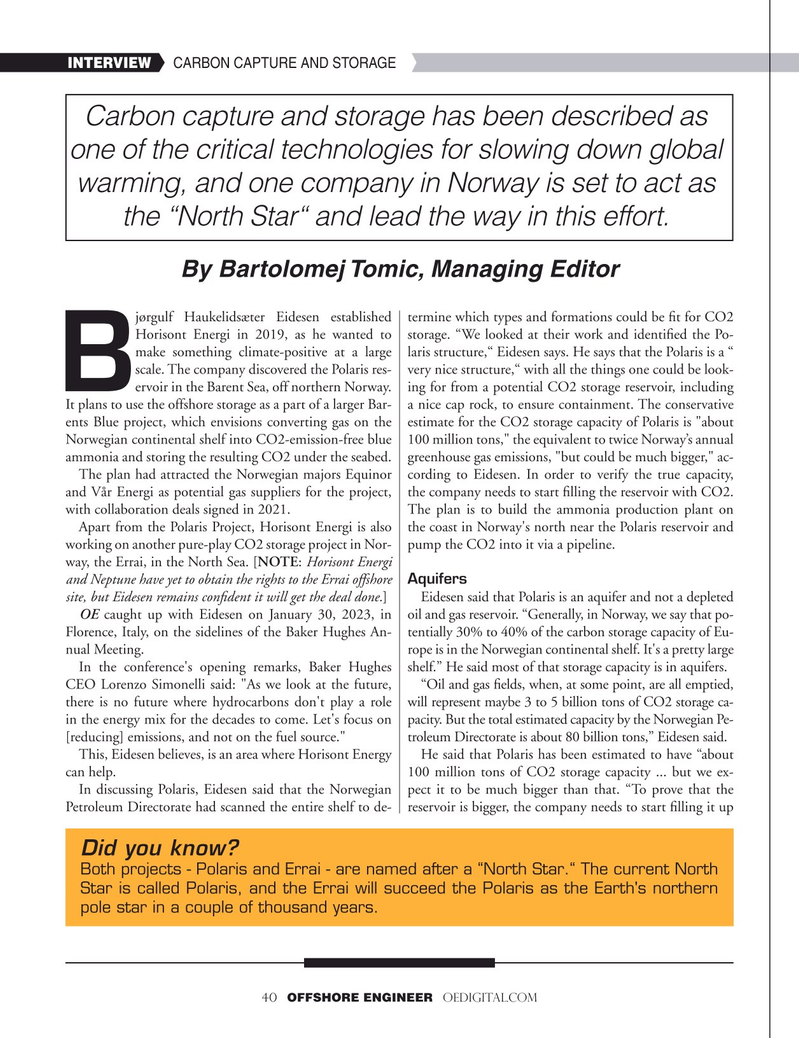
Page 40: of Offshore Engineer Magazine (Jan/Feb 2023)
Read this page in Pdf, Flash or Html5 edition of Jan/Feb 2023 Offshore Engineer Magazine
INTERVIEW CARBON CAPTURE AND STORAGE
Carbon capture and storage has been described as one of the critical technologies for slowing down global warming, and one company in Norway is set to act as the “North Star“ and lead the way in this effort.
By Bartolomej Tomic, Managing Editor jørgulf Haukelidsæter Eidesen established termine which types and formations could be ?t for CO2
Horisont Energi in 2019, as he wanted to storage. “We looked at their work and identi?ed the Po- make something climate-positive at a large laris structure,“ Eidesen says. He says that the Polaris is a “ scale. The company discovered the Polaris res- very nice structure,“ with all the things one could be look-
Bervoir in the Barent Sea, off northern Norway. ing for from a potential CO2 storage reservoir, including
It plans to use the offshore storage as a part of a larger Bar- a nice cap rock, to ensure containment. The conservative ents Blue project, which envisions converting gas on the estimate for the CO2 storage capacity of Polaris is "about
Norwegian continental shelf into CO2-emission-free blue 100 million tons," the equivalent to twice Norway’s annual ammonia and storing the resulting CO2 under the seabed. greenhouse gas emissions, "but could be much bigger," ac-
The plan had attracted the Norwegian majors Equinor cording to Eidesen. In order to verify the true capacity, and Vår Energi as potential gas suppliers for the project, the company needs to start ?lling the reservoir with CO2. with collaboration deals signed in 2021. The plan is to build the ammonia production plant on
Apart from the Polaris Project, Horisont Energi is also the coast in Norway's north near the Polaris reservoir and working on another pure-play CO2 storage project in Nor- pump the CO2 into it via a pipeline.
way, the Errai, in the North Sea. [NOTE: Horisont Energi and Neptune have yet to obtain the rights to the Errai offshore Aquifers site, but Eidesen remains con?dent it will get the deal done.] Eidesen said that Polaris is an aquifer and not a depleted
OE caught up with Eidesen on January 30, 2023, in oil and gas reservoir. “Generally, in Norway, we say that po-
Florence, Italy, on the sidelines of the Baker Hughes An- tentially 30% to 40% of the carbon storage capacity of Eu- nual Meeting. rope is in the Norwegian continental shelf. It's a pretty large
In the conference's opening remarks, Baker Hughes shelf.” He said most of that storage capacity is in aquifers.
CEO Lorenzo Simonelli said: "As we look at the future, “Oil and gas ?elds, when, at some point, are all emptied, there is no future where hydrocarbons don't play a role will represent maybe 3 to 5 billion tons of CO2 storage ca- in the energy mix for the decades to come. Let's focus on pacity. But the total estimated capacity by the Norwegian Pe- [reducing] emissions, and not on the fuel source." troleum Directorate is about 80 billion tons,” Eidesen said.
This, Eidesen believes, is an area where Horisont Energy He said that Polaris has been estimated to have “about can help. 100 million tons of CO2 storage capacity ... but we ex-
In discussing Polaris, Eidesen said that the Norwegian pect it to be much bigger than that. “To prove that the
Petroleum Directorate had scanned the entire shelf to de- reservoir is bigger, the company needs to start ?lling it up
Did you know?
Both projects - Polaris and Errai - are named after a “North Star.“ The current North
Star is called Polaris, and the Errai will succeed the Polaris as the Earth's northern pole star in a couple of thousand years.
40 OFFSHORE ENGINEER OEDIGITAL.COM

 39
39

 41
41